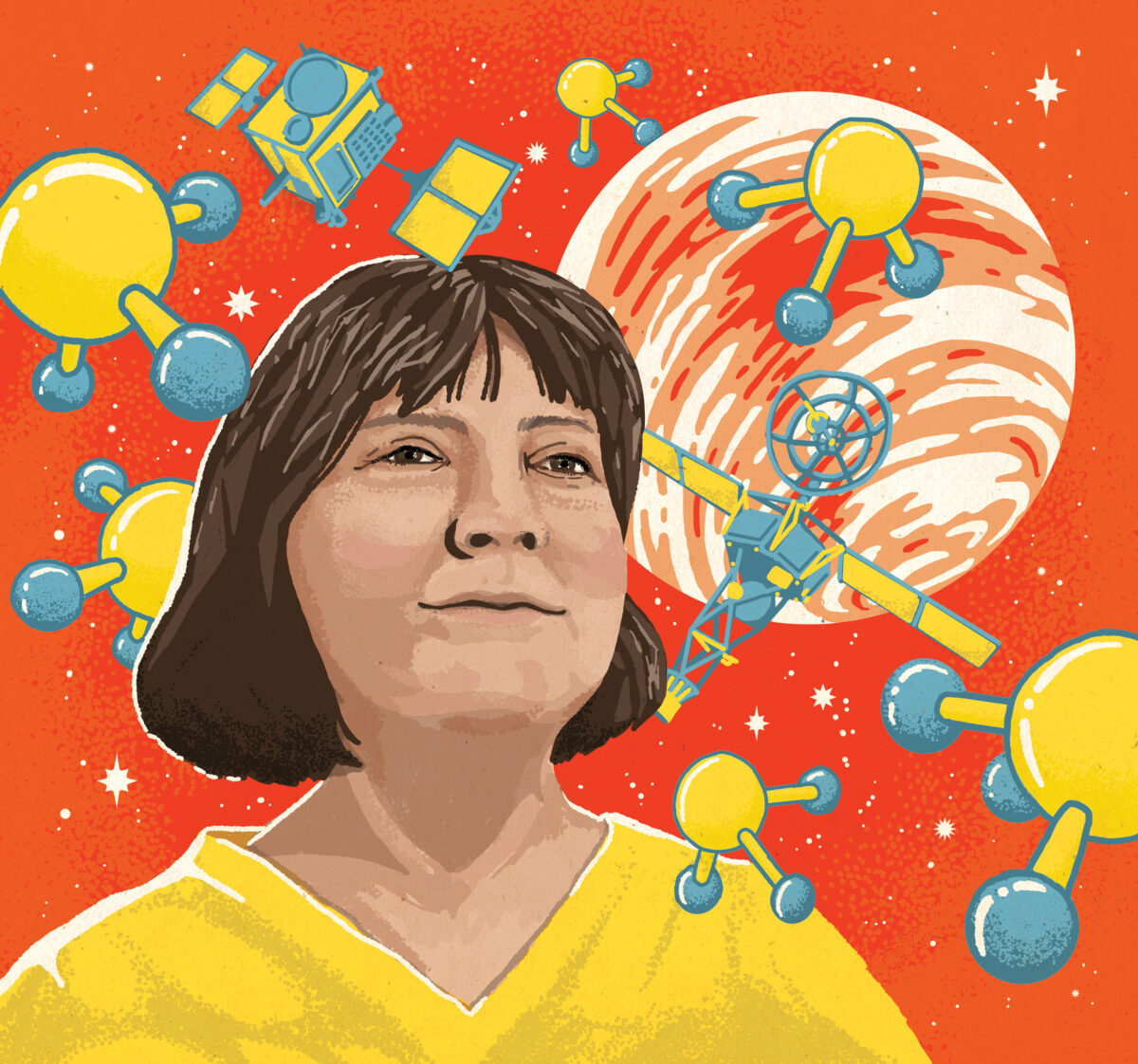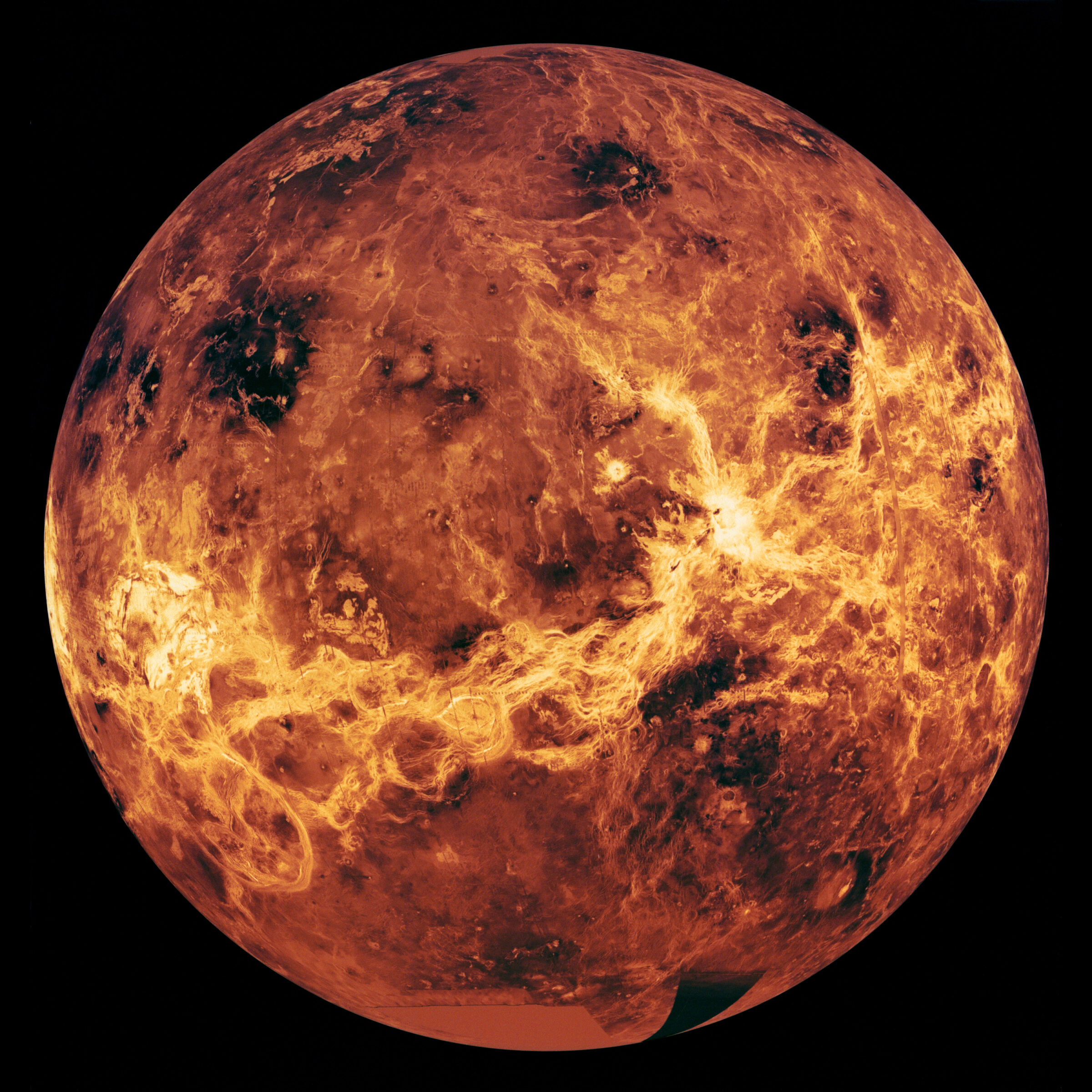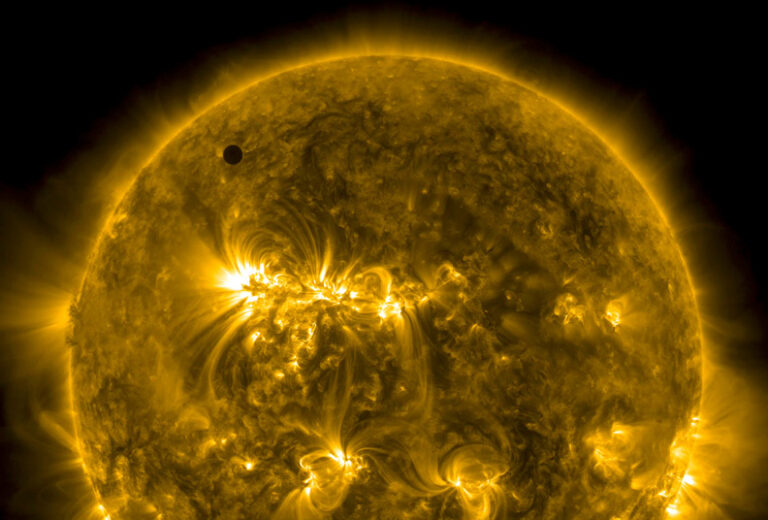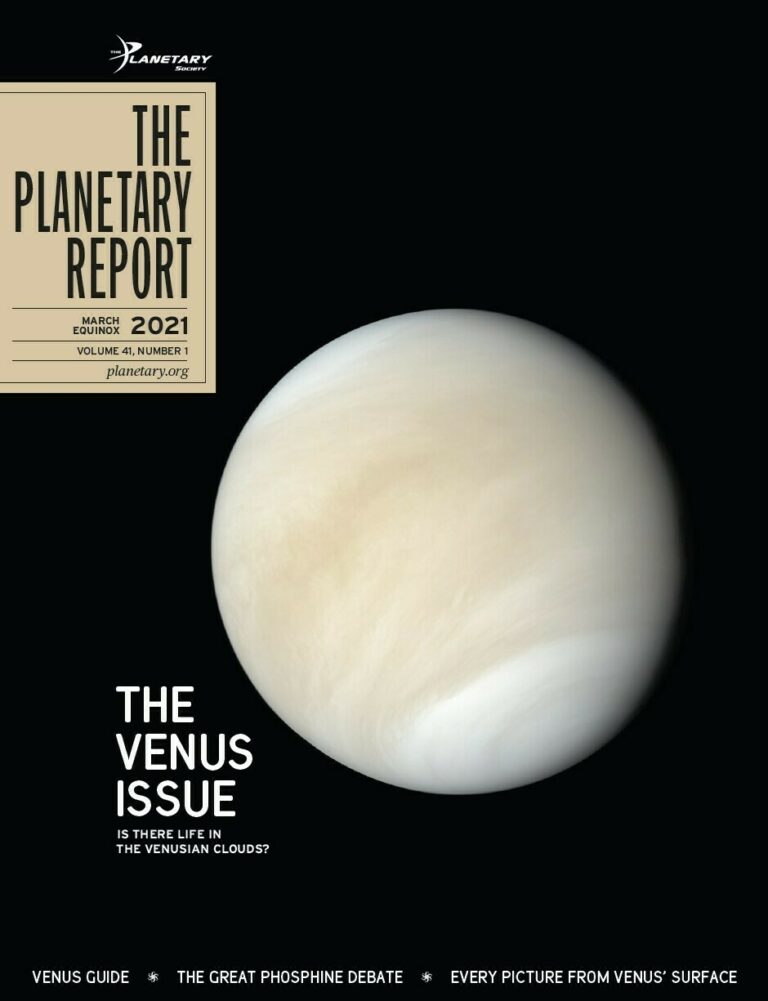The Quest for Life on Venus
Is Something Alive on the Planet Next Door?

One night in 2017, the James Clerk Maxwell Telescope in Hawai’i turned its 15-meter dish toward the bright-yellow dot of Venus. The telescope’s instruments dutifully recorded the light coming from the planet for Jane Greaves, an astronomer and astrobiologist at Cardiff University in Wales. Greaves and her team were looking for a little-known chemical called phosphine. On Earth, you can find phosphine in swamps, where bacteria produce it as a waste product. It’s also manufactured as an industrial fumigant to rid houses of moths, beetles, and fruit flies.
For decades, some scientists have theorized that Venus could harbor life in its upper atmosphere, where temperatures and pressures are benign despite the hellscape beneath. Nothing we know of on Venus could produce more than just a trace of phosphine—unless there is something living in the planet’s pale clouds.
A year later, as Greaves sat alone in her office, she saw what she was looking for in her Venus data: indications of phosphine. It wasn’t a strong signal, but it definitely seemed to be there. “I spent ages thinking there was nothing there, but one evening, I was pushing the data around, and suddenly, I realized it all came together,” Greaves told The Planetary Society. “That just blew me away. There really was phosphine.”
Venus, once hoped to harbor paradise, was written off as the most inhospitable place in the solar system. But Greaves’ finding has renewed interest in a planet some scientists say has been neglected for far too long. Did life ever flourish on Venus, and is there something still alive in its clouds, or will these latest findings only add to a long list of false hopes?
Before the Space Age, scientists considered Venus as Earth’s sister
planet, perhaps even habitable like our own. The two rocky worlds share
nearly the same size and density, and because a thick veil of clouds
shrouds Venus’ surface, some hoped that the world next door was a
tropical paradise with oceans and abundant vegetation.
NASA’s Mariner 2 spacecraft, the very first successful planetary
mission, dashed this idyllic view in December 1962. The probe flew past
Venus, recording temperatures of at least 150 to 200 degrees Celsius
(300 to 400 degrees Fahrenheit) and a punishing atmospheric pressure 20
times that of Earth’s.
“Venus Says No,” lamented a headline in the New York Times, opining that Mariner 2’s “message from Venus may mark the beginning of the end of mankind’s grand romantic dreams.”
Some scientists remained hopeful. In 1963, a young Harvard assistant professor named Carl Sagan—still years away from becoming a well-known science communicator—conjectured in the NASA film The Clouds of Venus that the planet’s harsh conditions might only exist in the atmosphere. “It is just possible that the surface temperature could then be almost Earthlike and life as we know it could exist there,” he said. “However, it is more likely that if there is life on Venus, it is probably of a type that we could not now imagine.”

Subsequent Soviet, U.S., and European missions in the 1960s and ‘70s only made the prospect of life worse, confirming it was the surface, not the atmosphere, that was oppressive. Revised average surface temperatures shot up to a scorching 470 degrees Celsius (880 degrees Fahrenheit)—hot enough to melt lead.
Additionally, space missions found that unlike Earth’s puffy water-vapor clouds, Venus’ clouds contained mostly carbon dioxide with droplets of skin-searing sulfuric acid. The clouds and carbon dioxide lock in the Sun’s warmth, creating a runaway greenhouse effect that bakes the planet.
“Our original vision of Venus was rudely destroyed,” said David Grinspoon, a senior scientist at the Planetary Science Institute and a long-time proponent of Venus exploration. “Venus has never fully recovered from dashing our dreams. And while it’s still shrouded in mystery, our attentions have since drifted to places in the solar system that are easier and more enticing to explore.”
Although Venus' surface turned out to be uninhabitable, another picture of the atmosphere began to emerge. Around 40 to 60 kilometers (25 to 37 miles) high, air pressures are similar to Earth, with temperatures between 0 and 50 degrees Celsius (32 to 122 degrees Fahrenheit). If you went flying through this region in a specialized gondola, you could probably step outside if you brought supplemental oxygen and wore protective gear for the sulfuric acid.
Encouraged by new findings, Sagan refined his thinking. In 1967, he coauthored a paper with biophysicist Harold Morowitz, pondering how life could exist in the Venusian clouds. “While the surface conditions of Venus make the hypothesis of life there implausible, the clouds of Venus are a different story altogether,” the authors wrote. “Water, carbon dioxide and sunlight—the prerequisites for photosynthesis—are plentiful in the vicinity of the clouds.” They envisioned blobs of hydrogen with microbes inside, wafting through the clouds collecting nutrients from minerals stirred up from the surface.
However, Venus’ fall from grace had already begun, and the world’s space agencies turned their attention to other destinations. The Soviet Union sent its final probes to Venus in 1984. NASA’s last Venus mission, Magellan, launched in 1989 to map the surface using a cloud-penetrating radar, allowing scientists to conclude that the planet’s volcanic surface has likely remained unchanged over the past several hundred million years.
The European Space Agency’s Venus Express spacecraft launched in 2005 and studied the planet until 2015, and Japan’s Akatsuki probe has been there since 2015. These missions found hints of past global oceans on Venus and in studying the atmosphere saw dynamic cloud formations, hurricane-like vortices at the poles, and wind that whips around the planet at hundreds of kilometers per hour. Our picture of Venus remains far from complete, especially on the topic of life.

The possibility of Venusian life always intrigued Jane Greaves. As an astrobiologist with an astronomy background, Greaves has a reputation for looking for unusual things. She has observed debris from comet collisions around other stars and used the aforementioned James Clerk Maxwell Telescope to study Pluto’s tenuous atmosphere.
In her Venus research, she learned that phosphine is considered a biomarker—a molecule related to biological processes—because it is hard to create from nonlife processes thought to occur on rocky worlds. On the off chance something were alive in the Venusian clouds, it might release phosphine, Greaves reasoned. It also appeared that no one had ever searched for that particular biomarker on Venus.
The signal Greaves saw in 2017 was a dip in the amount of light coming from the planet at a wavelength of about 1.12 millimeters. Different molecules block or absorb specific wavelengths, and for phosphine, that happens at 1.12 millimeters. These signals can be weak and difficult to detect without sensitive telescope instruments and advanced data-processing algorithms.
Greaves assembled an international team of 19 chemists, biologists, and astrophysicists to study her findings. In 2019, they secured time on the powerful Atacama Large Millimeter/submillimeter Array (ALMA) radio telescope system in northern Chile to observe Venus again. The phosphine light dip was still there, showing the molecule in low quantities—about 20 parts per billion.
That amount of phosphine is a thousand times less than what can be found in Earth’s atmosphere. Nevertheless, it defied all known explanations, such as tectonic and volcanic activity, meteors, lightning, and other chemical processes. Sunlight or sulfuric acid in the clouds should destroy the Venusian phosphine before it could accumulate to the quantities detected unless some kind of life was producing more of it.
Team member Clara Sousa-Silva, a research scientist at the Harvard-Smithsonian Center for Astrophysics and one of the few phosphine experts in the world, said the analysis was painstaking. “On my side, just figuring out alternative candidates for the signal—a never-ending task of finding every other molecule that cannot be responsible for the signal and then estimating the properties of the signals—took me many months,” she said.
On 14 September 2020, Greaves and her colleagues published the findings in the journal Nature Astronomy, stressing that the results were not a detection of life. Nature Astronomy made the article available for free, and the team published all of its data and methods for anyone to review. “We put the paper out in as open a way as possible,” Greaves said. “We wanted everyone—and we really meant everyone, even people at home—to work on it from different angles.”

While some members of the space community celebrated the findings, others were more skeptical. Within weeks, rebuttal analyses began appearing on arXiv, an open-access clearinghouse for preprint astronomy papers. Two groups examined Greaves’ original data and didn’t find evidence for phosphine, calling into question the processing techniques that were used. Another group searched for phosphine signals in archival Venus observations and came up empty. Then, technicians at the ALMA observatory found an error in the calibration system used to collect the Venus data. A corrected data set revised the amount of phosphine Greaves’ team detected from an average of 20 parts per billion down to 1, with spikes up to just 5 in some regions of the atmosphere. In early 2021, another paper suggested that the phosphine signal was actually sulfur dioxide, a gas that is common on Venus and is not a sign of possible life.
“All of this is not controversial—it’s science,” said Sousa-Silva. “My feelings are that all independent analyses of the existing data are not just uncontroversial but welcomed and crucial to this project. Over time and after revision, I expect our interpretations to converge on the truth, and I am impatient for that moment.”
The debate has at times been particularly contentious. One rebuttal took a condescending tone toward Greaves and her team; it has since been revised. A statement posted on the International Astronomical Union website chastised the researchers for announcing sensational findings that could lead to public overreaction. The IAU later removed the statement with apologies, saying it had been written by just a few members of an astrobiology subcommittee without broader input.
Grinspoon, the Venus scientist, noted there has been a history of strong reactions over scientific findings related to the search for life. Some observers attributed the backlash to gender issues—Greaves’ team is about half women—while others have pointed to the current political environment amid a global pandemic as a potential hair-trigger. “The tenor of the conversations on this topic has been very much less than professional, which is unfortunate,” said Rakesh Mogul, a professor of biological chemistry at California State Polytechnic University, Pomona. “Harsh critiques shouldn’t have any place in science right now.”
Mogul leads a team that offered some unexpected support for the phosphine findings: archival data from NASA’s 1978 Pioneer Venus Multiprobe mission, which carried a mass spectrometer to determine the composition of chemicals in Venus’ atmosphere. Although the instrument was not specifically designed to look for phosphine, Mogul’s team reprocessed the data it recorded and found what thus far appears to be phosphine. “The available data was literally just a table in a publication,” Mogul said. “It took us a while to figure out ways to trust the data and not overinterpret it.”
One of Mogul’s challenges is simply understanding the design of the instrument and the way the data were originally processed. His team members have become de facto data archeologists digging through old records, and they’ve called in one of the original mission scientists, Richard Hodges, to help. “He is pulling out code from 40 years ago, helping us to better understand these mass spectrometer signals,” Mogul said. “It’s been an honor and a great experience to work with him. We’re approaching this from multiple angles, trying to put this all together to have a full understanding of the data set.”

The phosphine question is one of many secrets Venus still has to teach us. Scientists still don’t know how Venus changed from a potentially habitable planet with oceans to an inhospitable wasteland. The answer will help us understand the possibilities for similar planets outside our own solar system and may serve as a cautionary tale for Earth.
As the current debate shows, phosphine is difficult to detect from ground-based telescopes. NASA’s airborne SOFIA telescope could possibly provide stronger evidence from above more of Earth’s light-distorting atmosphere, but it will ultimately take new space missions to settle the question of whether life exists on Venus.
ISRO, India's space agency, is eyeing 2023 for the launch of its Venus mission, called Shukrayaan, which will use radar and infrared cameras to map the planet’s surface. NASA is considering 2 Venus spacecraft concepts for its low-cost Discovery mission program; at least 1 of those could potentially detect phosphine or be tweaked to look for it more specifically. However, those spacecraft are up against 2 equally compelling missions to Neptune’s moon Triton and Jupiter’s moon Io. The agency will pick up to 2 winners this year, and some scientists and space fans are crossing their fingers that one will go to Venus.
“Sending a spacecraft there is long overdue,” Grinspoon said. “There are 1,001 reasons we need a new mission to Venus, and even if it turns out that there isn’t phosphine in the atmosphere, there will still be 1,000 reasons. There are so many mysteries there, and the ultimate way to answer them is to dive into those clouds, sample some particles, and figure out what’s going on.”
Support our core enterprises
Your support powers our mission to explore worlds, find life, and defend Earth. You make all the difference when you make a gift. Give today!
DonateThe Planetary Report • March Equinox
Help advance space science and exploration! Become a member of The Planetary Society and you'll receive the full PDF and print versions of The Planetary Report.


 Explore Worlds
Explore Worlds Find Life
Find Life Defend Earth
Defend Earth


